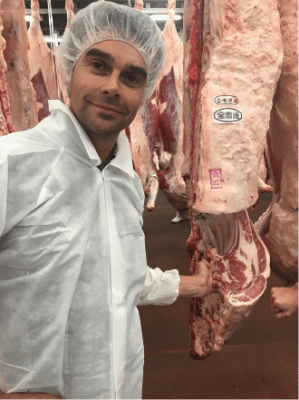A SIGNIFICANT change in consumer behaviour is prompting some beef producers to look beyond the farm gate and into the realm of vertical integration, as communities place greater emphasis on quality, welfare and transparency.

John Finlayson
Understanding the risks and rewards of the beef value chain has been the focus for study by NSW beef producer, John Finlayson, who received a 2016 Nuffield Scholarship.
For the past eighteen months, Mr Finlayson has researched how Australian red meat producers can work more effectively with processors and retailers to promote a quality product and to better mitigate the risks of farming.
His research found that consumer awareness is forcing a shift away from the traditional model of maximum beef production at minimal cost, to one that encompasses ethical, sustainable and environment practices.
Returning to the family farm from a corporate career in the United States in 2004, Mr Finlayson now manages a 2200 hectare sheep and cattle grazing business, known as Pointsfield Pastoral Group, just outside Armidale, NSW.
“In our farm business, there’s a focus on cost of production and grazing efficiency, which enables us to produce a consistent meat product and manage any fluctuations in the market and the season,” he said.
“However, drier than usual conditions, as well as growing consumer awareness, is encouraging us to look beyond the farm gate to understand how we can implement a stronger, more sustainable production model.
“Beef is expensive to produce compared to other proteins, but if a beef product is unique in the market, and consumers view it as such, then it can sell at a premium which means more insulation from changes at the retail level.”
With the current dry gripping most of NSW, Mr Finlayson said that future proofing the farm business was more critical than ever, and a key way to help achieve this was through vertical integration.
On his Nuffield scholarship, he travelled to Brazil, New Zealand, Uruguay and the US to research successful models of vertical integration in the beef industry, ranging from owning the entire supply chain to working with trusted partners, as well as co-operatives and contractors.
“Across the Tasman, the Atkins Ranch company is utilising the ‘partner model’ which sees it supply its New Zealand lamb direct to the US market and work with key suppliers who have varying levels of investment in the program,” he said.
“The company believes the future of red meat relies on interaction with the consumer and, as such, incorporates well known US terms in packaging, such as ‘ranch’ rather than ‘farm’ and ‘T-bone’ rather than ‘loin chop’, to appeal to a US consumer base.
The brand promotes an all-natural product underpinned by the clean, green imagery of New Zealand, and provides the link between producer and consumer.
“It’s an authentic story that helps to differentiate the product from other brands,” Mr Finlayson said.
On his travels, he met Sue and Bill Garland from Rahiri Farm near Cambridge, New Zealand, who supply lambs into the Atkins Ranch program.
Aside from market premiums, one of their primary reasons for supplying the company was the guarantee of sale and the forward commitment to space and numbers to the nearby slaughter facility.
“My research found that partnering with trusted suppliers is a lower-risk model for supply chain participants, with each requiring less capital. Ultimately though, the producer was still found to be the one at most risk, as the model doesn’t account for poor climatic conditions.”
On his Nuffield travels, Mr Finlayson discovered a fully-integrated supply chain business in Colorado, called Callicrate Beef, owned by Mike Callicrate, a strong advocate for delivering fairer returns for farmers. He claimed that in the past six years, American retail grocers had received a 21 percent return on their equity, meat packers 17pc and farmers only 0.54pc.
Mr Callicrate had built Callicrate Beef from the ground up, including a retail store, value-adding plant, an abattoir, a feedlot and grazing land to breed on. The business produces a grass raised and grain finished product to ensure consistency of eating quality.
“The benefits of having an owned and operated supply chain is that the producer can have complete quality control, from guaranteeing the animal’s welfare, right through to the retail shop offering beef and pork produced on farm,” Mr Finlayson said.
He also investigated cooperatives where members work together to benefit producer and processor, and cited Alliance Meats in New Zealand, which is 100pc farmer-owned, with more than 5000 farmer shareholders, with a turnover of NZ$1.4 billion per annum.
“Alliance offers its members the scale to take their products to a large domestic and export market, with access to distributors in over 65 countries, which is crucial for NZ farmers who export 95pc of their production,” he said.
One of Mr Finlayson’s research conclusions was that a successful beef value chain, operating in a domestic or export market, must ensure that it stays strongly connected to the consumer.
“If we can identify supply chain alliances and grow the general understanding of the changing requirements and preferences of the consumer, then we can better attract domestic and international premiums for our beef,” he said.
Mr Finlayson’s scholarship was supported by Rabobank Australia.



HAVE YOUR SAY